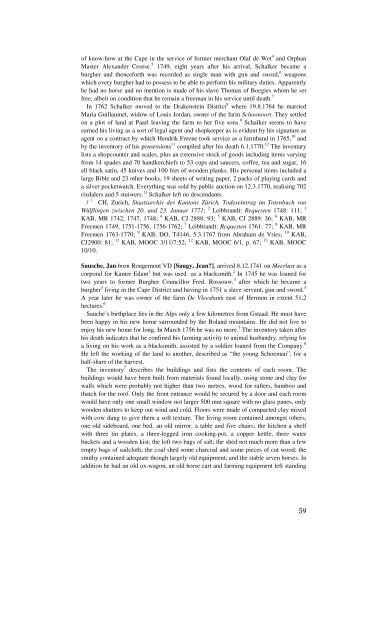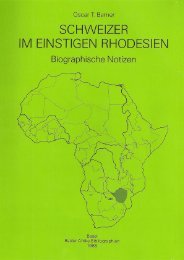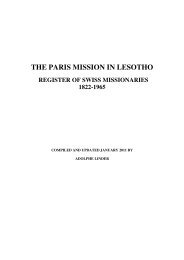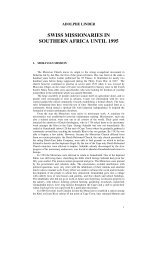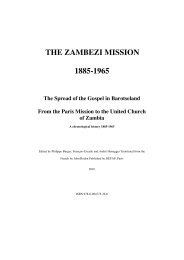THE SWISS IN SOUTHERN AFRICA 1652-1970 - swissroots-za.ch
THE SWISS IN SOUTHERN AFRICA 1652-1970 - swissroots-za.ch
THE SWISS IN SOUTHERN AFRICA 1652-1970 - swissroots-za.ch
You also want an ePaper? Increase the reach of your titles
YUMPU automatically turns print PDFs into web optimized ePapers that Google loves.
of know-how at the Cape in the service of former mer<strong>ch</strong>ant Olaf de Wet 4 and Orphan<br />
Master Alexander Croese. 5 1749, eight years after his arrival, S<strong>ch</strong>alker became a<br />
burgher and thenceforth was recorded as single man with gun and sword, 6 weapons<br />
whi<strong>ch</strong> every burgher had to possess to be able to perform his military duties. Apparently<br />
he had no horse and no mention is made of his slave Thomas of Boegies whom he set<br />
free, albeit on condition that he remain a freeman in his service until death. 7<br />
In 1762 S<strong>ch</strong>alker moved to the Drakenstein District 8 where 19.8.1764 he married<br />
Maria Guillaumet, widow of Louis Jordan, owner of the farm S<strong>ch</strong>oonoort. They settled<br />
on a plot of land at Paarl leaving the farm to her five sons. 9 S<strong>ch</strong>alker seems to have<br />
earned his living as a sort of legal agent and shopkeeper as is evident by his signature as<br />
agent on a contract by whi<strong>ch</strong> Hendrik Freene took service as a farmhand in 1765, 10 and<br />
by the inventory of his possessions 11 compiled after his death 6.1.1770. 12 The inventary<br />
lists a shopcounter and scales, plus an extensive stock of goods including items varying<br />
from 14 spades and 70 handker<strong>ch</strong>iefs to 53 cups and saucers, coffee, tea and sugar, 16<br />
ell black satin, 45 knives and 100 feet of wooden planks. His personal items included a<br />
large Bible and 23 other books, 19 sheets of writing paper, 2 packs of playing cards and<br />
a silver pocketwat<strong>ch</strong>. Everything was sold by public auction on 12.3.1770, realising 702<br />
rixdalers and 5 stuiwers. 13 S<strong>ch</strong>alker left no descendants.<br />
/ 1 CH, Zuri<strong>ch</strong>, Staatsar<strong>ch</strong>iv des Kantons Züri<strong>ch</strong>, Todeseintrag im Totenbu<strong>ch</strong> von<br />
Wülflingen zwis<strong>ch</strong>en 20. und 23. Januar 1771; 2 Leibbrandt: Requesten 1748: 111; 3<br />
KAB, MR 1742, 1747, 1748; 4 KAB, CJ 2888: 93; 5 KAB, CJ 2889: 36; 6 KAB, MR<br />
Freemen 1749, 1751-1756, 1756-1762; 7 Leibbrandt: Requesten 1761: 77; 8 KAB, MR<br />
Freemen 1763-1770; 9 KAB, DO, T4146, 5.3.1767 from Abraham de Vries; 10 KAB,<br />
CJ2900: 81; 11 KAB, MOOC 3/11/7:52; 12 KAB, MOOC 6/1, p. 67; 13 KAB, MOOC<br />
10/10.<br />
Saus<strong>ch</strong>e, Jan born Rougemont VD [Saugy, Jean?], arrived 8.12.1741 on Meerlust as a<br />
corporal for Kamer Edam 1 but was used as a blacksmith. 2 In 1745 he was loaned for<br />
two years to former Burgher Councillor Fred. Rossouw, 3 after whi<strong>ch</strong> he became a<br />
burgher 4 living in the Cape District and having in 1751 a slave servant, gun and sword. 5<br />
A year later he was owner of the farm De Vleesbank east of Hermon in extent 51,2<br />
hectares. 6<br />
Sau<strong>ch</strong>e’s birthplace lies in the Alps only a few kilometres from Gstaad. He must have<br />
been happy in his new home surrounded by the Boland mountains. He did not live to<br />
enjoy his new home for long. In Mar<strong>ch</strong> 1756 he was no more. 7 The inventory taken after<br />
his death indicates that he confined his farming activity to animal husbandry, relying for<br />
a living on his work as a blacksmith, assisted by a soldier loaned from the Company. 8<br />
He left the working of the land to another, described as “the young S<strong>ch</strong>oeman”, for a<br />
half-share of the harvest.<br />
The inventory 7 describes the buildings and lists the contents of ea<strong>ch</strong> room. The<br />
buildings would have been built from materials found locally, using stone and clay for<br />
walls whi<strong>ch</strong> were probably not higher than two metres, wood for rafters, bamboo and<br />
that<strong>ch</strong> for the roof. Only the front entrance would be secured by a door and ea<strong>ch</strong> room<br />
would have only one small window not larger 500 mm square with no glass panes, only<br />
wooden shutters to keep out wind and cold. Floors were made of compacted clay mixed<br />
with cow dung to give them a soft texture. The living room contained amongst others,<br />
one old sideboard, one bed, an old mirror, a table and five <strong>ch</strong>airs; the kit<strong>ch</strong>en a shelf<br />
with three tin plates, a three-legged iron cooking-pot, a copper kettle, three water<br />
buckets and a wooden kist; the loft two bags of salt; the shed not mu<strong>ch</strong> more than a few<br />
empty bags of sailcloth; the coal shed some <strong>ch</strong>arcoal and some pieces of cut wood; the<br />
smithy contained adequate though largely old equipment; and the stable seven horses. In<br />
addition he had an old ox-wagon, an old horse cart and farming equipment left standing<br />
59


